
Andy Lloyd's Dark Star Blog

Blog 15 (June 2014)
The Kozai Effect and our Haunted Solar System
Imagine that you come home to an empty house, and while you're pottering around downstairs you hear a noise upstairs. Upon investigating, however, you fail to discover anyone upstairs. So you head back downstairs to make a drink, and then you hear another creak up there, like someone's walking around. This time you look around more thoroughly, checking wardrobes and closets. Still no one to be found. After a while of this repeatedly happening, you begin to wonder what the heck is going on.
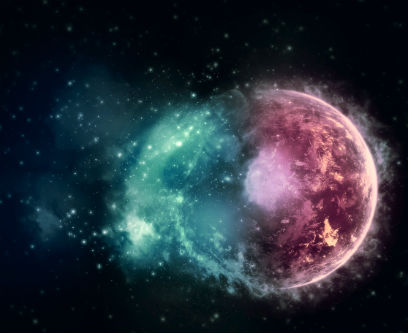
Well, this scenario could be an analogy for a missing Planet X body in the outer solar system. Astronomers have been looking 'out there' for another planet for over 100 years, and a great deal of anomalous data has suggested its existence during that time (1). Their search turned up Pluto back in 1930, and in recent decades a large number of smaller Pluto-like objects that together make up the Kuiper Belt located beyond the planet Neptune. Yet, despite searches with powerful optical and infra-red telescopes, no Planet X object has yet emerged from the gloom.
So, is the solar system's upstairs clear of occupants? Not according to the data from the newest and most distant objects discovered out there, the so-called extreme trans-Neptunian objects or ETNOs (2). These asteroids never get closer to the Sun than distant Neptune, and extend out beyond 150 Astronomical Units, which is five times that distance. Analyses of their orbital paths indicate that they are collectively being affected by much larger, more distant objects - possibly two planets sized "between Mars and Saturn" (3).
What has become clear from the work of astrophysicists Carlos and Raul de la Fuente Marcos, of the Complutense University of Madrid, is that the anomalous data suggesting massive distant worlds beyond Neptune cannot be put down to observational bias, but is very real - meaning that the weird sound you heard upstairs was not your imagination! This is what they say in the abstract to their academic paper:
"Here, we study the visibility of these ETNOs and confirm that the observed excess of objects reaching perihelion near the ascending node cannot be explained in terms of any observational biases. This excess must be a true feature of this population and its possible origin is explored in the framework of the Kozai effect. The analysis of several possible scenarios strongly suggest that at least two trans-Plutonian planets must exist." (2)
The Kozai mechanism is an important theoretical consideration here, and one that has cropped up before in discussions about the possible existence of Planet X. Here's a brief description of its practical implications for eccentric bodies in our solar system, as well as exoplanets in other star systems beyond:
"The Kozai Mechanism causes a periodic exchange between the inclination and eccentricity of an orbit.
"It has been theorized that the Kozai Mechanism is responsible for the high eccentricities observed in the orbits of exosolar planets. If the parent star has a massive yet unseen substellar companion, orbiting at a great distance, and in an orbit highly inclined to the plane of the planets' orbits, the Kozai Mechanism should induce high eccentricities into the orbits of the planets.
"It is also theorized that the Kozai Mechanism may be responsible for the high eccentricities observed in the orbits of many Kuiper Belt Objects such as 2003 UB313. The pull of the Milky Way Galaxy causes an object with a high eccentricity to periodically trade this eccentricity for a gain in inclination.
"The Jovian system is influenced by the Kozai Mechanism as well. Although Jupiter has many irregular, distant moons orbiting in a myriad of directions, the Kozai Mechanism has set an upper limit of about 60 degrees on their inclinations. Any moon whose inclination exceeded this value would periodically gain an eccentricity so large that its perijove would take it into the region of the Galilean Moons. Its fate would be a collision with one of the Galilean Moons, a collision with Jupiter, or an ejection from the Jovian system." (4)
In our hunt for Planet X, the Kozai mechanism is therefore both a helpful theoretical tool for understanding how the orbits of these ETNOs might be getting affected by more distant, massive bodies; but also a consideration that potentially limits the grounds for a sub-stellar companion. Why? Because, in a similar way to the Jovian example above, a highly-inclined massive sub-stellar companion might distort other planetary orbits in the solar system so dramatically as to bring about a highly chaotic, even unstable arrangement - one that is, arguably, not seen in the present solar system. That said, there was plenty of catastrophic and migratory activity evident in the early solar system, potentially indicating the Kozai effect at work at that time.
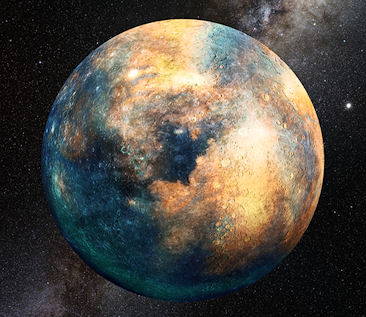
Which brings me back to my initial analogy. These footfalls heard upstairs (the perturbed orbits of the extreme trans-Neptunian objects) seem to indicate the presence of a ghost! Every time we seek out the source of the sounds, the culprit has disappeared. We know it's not down to our imaginations. We think that our powers of observation thus far should have been up to the task (5). So, either it's hiding in the attic (i.e. way out in the Oort Cloud) or the sounds are being produced by a ghost.
A ghost planet, perhaps? It is almost as if the solar system is haunted.
Now, there are plenty of Planet X researchers on the fringe who have speculated about all kinds of exotic solutions for Planet X to explain its seeming embarrassment about coming out into the open. I've heard of tiny black holes, plasma stars, and even cloaked planets! I'm not convinced by any of these arguments, but I can see why researchers have brought their (often wild) imaginations of bear upon this problem. Simply put, despite astronomers scouring the rooms upstairs for evidence of occupation and come up with nothing, the anomalous sounds up there simply won't go away!
There's only one other possibility remaining: We've been sending trusted people upstairs to investigate, and they've been coming back down to reassure us that nobody's up there, when they know damn well there is...
Written by Andy Lloyd, 23rd June 2014
References:
1) Andy Lloyd "Dark Star: The Planet X Evidence" Timeless Voyager Press, 2005, pp80-1
2) C. de la Fuente Marcos, R. de la Fuente Marcos "Extreme trans-Neptunian objects and the Kozai mechanism: signalling the presence of trans-Plutonian planets" Monthly Notices of the Royal Astronomical Society: Letters, 443(1): L59–L63, 1 September 2014, with thanks to Adam
3) Nicola Jenner "Two giant planets may cruise unseen beyond Pluto" 11 June 2014 with thanks to Lee
4) Tony Dunn "The Kozai Mechanism" 2000
5) Lorenzo Iorio "Perspectives on effectively constraining the location of a massive trans-Plutonian object with the New Horizons spacecraft: a sensitivity analysis" Celestial Mechanics and Dynamical Astronomy, 116: 357–366, 2013, with thanks to Adam
A Very Old Prediction of Two trans-Neptunian Planets
It came as something of a surprise to me that a similar scenario regarding two undiscovered planets beyond Neptune was predicted as long ago as 1880, by a Scottish electrical engineer and astronomer George Forbes (1), fifty years before the discovery of Pluto by the Planet X-seeking astronomer Clyde Tombaugh (2,3).

George Forbes
Barry Warmkessel, the Dark Star researcher who advocates the existence of a planet known as Vulcan, discussed the Scot's input on the Google Dark star Planet X forum (4). Here's a short extract from Barry's website:
"George Forbes was the first to predict hypothetical planetary orbits from the aphelion of trans-Neptunian comets in 1880. Forbes predicted a planet with orbital parameters similar to those of Vulcan’s. He also predicted a planet at 87-122 AU with a 1,076-year orbit." (5)
You can see the similarities on Barry's table of comparative orbital parameters (6):
In correspondence to me, Adam Crowl contemplates whether two such objects might essentially cancel each other out, thus mitigating any distorting effect upon the solar system over time:
"In the case of the Trans-Plutonian planets, if one is at 205 AU and the other at 265 AU, and their mass-ratio is (265/205)^2, then putting them on almost opposite sides of the Sun will cancel most of their Ecliptic plane influence on the inner planets. Their orbital periods are so large that we'd only notice changes over centuries and near opposed configurations would last thousands of years. They will be noticed by an additional perturbation of out-of-plane comets directed towards the mutual orbital plane of the extra planets, which might provide some kind of observational signature." (7)
Adam was thinking more about problems revolving around the Kozai mechanism, but such a scenario might also provide helpful insight into other anomalies, e.g. the perturbation of the trajectories of the Pioneer spacecraft but not the Voyagers (8).
Written by Andy Lloyd, 23rd June 2014
References:
1) J.S. McGarth "Significant Scots: George Forbes"
2) George Forbes "ON COMETS", Proc. Roy. Soc. Edinburgh; 10: 1878 - 80; pg. 426, and "ADDITIONAL NOTE ON AN ULTRA-NEPTUNIAN PLANET"; 11: 89, with thanks to Barry
3) George Forbes, Monthly Notices Of The Royal Astronomical Society, 69: pg. 152, 1908 - 1909, with thanks to Barry
4) Dark Star Planet X thread "Two giant planets may cruise unseen beyond Pluto" 15 June 2014
5) Barry M. Warmkessel "Vulcan and Earth Catastrophism: The Beginning of the End", 2004,
bibliotecapleyades.net article
6) Reproduced with kind permission from Barry Warmkessel
7) Correspondence from Adam Crowl, 19 June 2014
8) Andy Lloyd "Pioneer and Voyager" 2000
Oceans of Water Trapped inside the Earth
The prevailing theory about where Earth's water came from centres around multiple collisions with water-bearing comets through its lifetime. How else to explain the beautiful oceans of water resting upon the surface of a relatively warm world located so close to the Sun? We now know that water is common through the solar system, but the planets closer to the Sun generally lose it over time. Not the Earth, though.
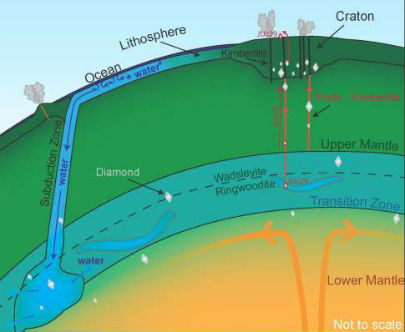
Other planets (well, moons of the gas giants to be more precise) have oceans of water located beneath thick layers of surface ice, offering tantalizing prospects for the discovery of extra-terrestrial aquatic life-forms in the future. Now, recent discoveries have led scientists to conclude that the Earth may also have vast swathes of water located deep below the surface - as far as 400 miles down! This area is known as the transition zone of the Earth's mantle Estimates of these reserves of deep water are staggering:
"If just 1% of the weight of mantle rock located in the transition zone was water it would be equivalent to nearly three times the amount of water in our oceans, [geophysicist Steve] Jacobsen [from Northwestern University in the U.S.] said." (1)
The transition zone is now known to include a mineral called ringwoodite which acts like a sponge, soaking up and trapping water. Jacobsen speculates that water trapped in the Earth's mantle in this way may be part of a 'whole-Earth water cycle', allowing movement of water to the Earth's surface driven by geological activity. This cycle may then explain the existence of the Earth's oceans, without the need to rely upon cometary impacts.
Herein lies the classic battle between Earth-centred scientists like geophysicists, and astronomers who see Earth as part of a larger picture. Irrespective of that debate, this potential explanation provides Earth with an awful lot more water that previously thought. This 'ringwoodite reservoir' is presumably made up of vast swathes of primordial water which became trapped during the early Earth's titanic geological development, Which makes the Earth very much a water-world. Here's Dr Jacobsen again:
"If [stored water] wasn't there, it would be on the surface of the Earth and mountaintops would be the only land poking out." (1)
Sitchinites will find this a welcome development. After all, in Sitchin's theory, the Earth was indeed initially a water-covered world which lost much of that water as a result of a collision, or encounter, with a transiting rogue planet. The discovery of huge sources of underground water might provide further clues to that watery past.
Written by Andy Lloyd, 15th June 2014
Reference:
1) Melissa Davey "Massive 'ocean' lies beneath the Earth's Surface" The Guardian, p15, 14th June 2014,
Earth's Fluctuating Magnetic Field
I would imagine that the proposed oceans of trapped water below the Earth's surface mentioned in the previous item might be contributing to the Earth's magnetic field?
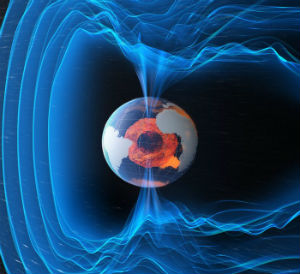
Scientists are now far better equipped to monitor the changing patterns of the planet's magnetic field thanks to 'Swarm':
"The first set of high-resolution results from ESA’s three-satellite Swarm constellation reveals the most recent changes in the magnetic field that protects our planet. Launched in November 2013, Swarm is providing unprecedented insights into the complex workings of Earth’s magnetic field, which safeguards us from the bombarding cosmic radiation and charged particles.
"Measurements made over the past six months confirm the general trend of the field’s weakening, with the most dramatic declines over the Western Hemisphere. But in other areas, such as the southern Indian Ocean, the magnetic field has strengthened since January. The latest measurements also confirm the movement of magnetic North towards Siberia. These changes are based on the magnetic signals stemming from Earth’s core. Over the coming months, scientists will analyse the data to unravel the magnetic contributions from other sources, namely the mantle, crust, oceans, ionosphere and magnetosphere." (1)
It's pretty clear that the overall magnetic field is subject to a number of environmental and geophysical factors, and disentangling all of these elements presents some major challenges for scientists studying this new stream of data. What might this tell us about what our planet is made of, where and how it formed, and what affected it from elsewhere in the solar system?
Written by Andy Lloyd, 23rd June 2014
Reference:
1) ESA Press Release "Swarm Reveals Earth's Changing Magnetism" 19 June 2014, with thanks to Peter
Mysteries of Brown Dwarf Formation Remain
Astronomers seeking life beyond our solar system are increasingly looking to the dwarf star systems to find life-supporting planets. Our Sun is actually classified as a yellow dwarf star, and the next step down in the pecking order are the red dwarfs. These are highly numerous in the galaxy, with many red dwarfs in our stellar neighbourhood. Recently, there has been some scepticism about whether planets in the habitable zones of red dwarf stars might be capable of supporting life. They would have to lie very close to the parent star, but in doing so would then be subject to their highly energetic emissions in the form of stellar flares and other extreme space weather (1). The protection afforded by the planet's magnetic field may be insufficient to prevent the orbiting world from being periodically irradiated by highly destructive radiation.
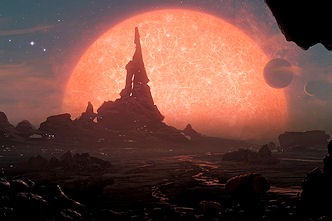
So, how about smaller dwarf stars? Surely the radiation they emit would be on a far lesser scale? The next category of dwarf stars are the brown dwarfs (which, quixotically, are also red). They are essentially failed stars ranging from hot Jupiters of 16 Jupiter masses right up to their bigger sisters, the red dwarfs, at about 80 Jupiter masses. Some of these brown dwarfs are individual, free-floating 'stars' in their own right, while others are companions to larger parent stars. Habitable planets orbiting around these failed stars would need to be closer still than those around red dwarfs, but the threat from irradiation would be far less as the brown dwarfs are much less active than red dwarfs.
However, brown dwarfs are still not very well understood, mainly because they are so cool that they are difficult to discover and study. This has left gaps in our knowledge that have implications as far-ranging as our understanding of how stars form in the first place:
"[Andrew] West [assistant professor at Boston University's department of astronomy] says one big unanswered question is how the very smallest stars and brown dwarfs--objects less massive than stars, but more massive than planets--form.
"We really don't understand the details of how these processes work," he says. "They have not been studied in great detail in the past, and there is a lot of uncertainty about the mechanisms that lead to forming stars of this size or brown dwarfs, these 'failed' stars, if you will." (1)
Typically, stars form within clouds of dust and gas when there is sufficient mass to collapse by gravitational attraction.
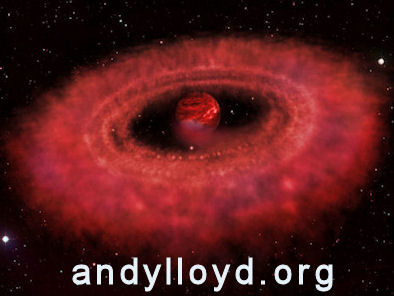
As the cloud collapses, the material at the center begins to heat up, a hot core in the heart of the collapsing cloud that ultimately will become a star.
"A big cloud of hydrogen gas may spit out a thousand stars," West says. "It spits out stars with a variety of masses, but the number of stars in each mass is not uniform. We know from previous work that there are all different sizes, higher mass stars and lower mass stars. But when you get to the end of the stellar sequence, to forming the small ones, we don't really have a good idea of how many stars get formed in the process," he adds. "It turns out that this is a very important data point that can help constrain different scenarios of star formation." (2)
The difficulty in their detection and study increases almost exponentially as you drop still further down the dwarf star league. Between the gas giant planets and the smallest of these brown dwarfs are the sub-brown dwarfs.
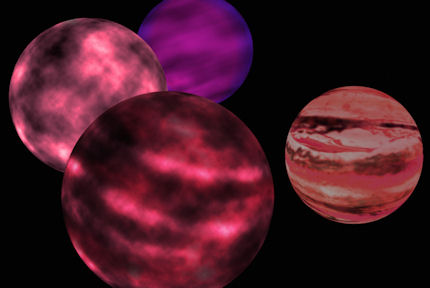
Until recently, their very existence was theoretical, but examples have been discovered, mostly orbiting in tight, sometimes eccentric orbits around distant stars. It is only the wobble of the parent stars themselves, as their movement through space fluctuates due to the gravitational interaction with their sub-brown dwarf companion, that leads to the companion's discovery. And only the mightiest telescopes built, and in the planning stages of being built (like the Extremely Large Telescope in Chile (3)), have any hope of studying them closely. Until then, these 'dark Stars' will hold on to their secrets.
Written by Andy Lloyd, 23rd June 2014
References
1) Harvard-Smithsonian Center for Astrophysics "Harsh space weather may doom potential life on red-dwarf planets" 2 June 2014 with thanks to Lee
2) Marlene Cimons “Red dwarf stars tell us how planets form” 16 June 2014 with thanks to Lee
3) Ian Sample "Scientists Trim Mountain to Reach the Stars" The Guardian, p15, 19 June 2014

You can keep informed of updates by following me on Twitter:
![]()
Or like my Facebook Page: https://www.facebook.com/darkstarandylloyd